
-
Shop by Type
-
Shop by Culture
-
Collections
Home » Blog » Christian Symbols » Orthodox Cross Pendant & Necklace: History, Meaning, and Designs

The Orthodox Cross, worn as both a necklace and a pendant, is a sacred emblem of faith, tradition, and identity. From the ornate styles of the Russian Orthodox tradition to the refined lines of the Greek Orthodox Cross, each design tells a story spanning centuries. This article explores the history, symbolism, and variations of Orthodox crosses, offering insight into both their spiritual meaning and their evolving designs in jewelry. For those ready to wear this symbol, explore our Orthodox Cross necklaces and pendants.
The Orthodox cross, also known as the Byzantine cross, has its roots in early Christianity and the Byzantine Empire. The design of the cross has evolved over centuries, reflecting various theological and cultural influences. Unlike the simple Latin cross, the Orthodox cross often features additional bars and intricate detailing, symbolizing different aspects of the Christian faith.
Over time, these meaningful designs came to be worn in two main forms—pendants (paired with a variety of chains) and complete necklaces—each carrying the same profound symbolism.
In the early days of Christianity, the cross was a symbol of suffering and execution. However, with the resurrection of Jesus Christ, it became a symbol of victory over death and a representation of eternal life. The Byzantine Empire, which played a crucial role in the spread of Christianity, adopted the cross as a central symbol of faith. Byzantine artisans created elaborate crosses adorned with precious stones and intricate carvings, setting the standard for Orthodox cross designs.
The adoption of the cross in personal adornment led to a thriving tradition of Orthodox Cross pendants and necklaces, uniting devotion with craftsmanship.
The Orthodox cross is rich with symbolism, each element carrying a specific meaning. The most common form of the Whether worn as a pendant or as a complete necklace, the structure of the Orthodox Cross conveys layered theology. The most common form of the Orthodox Cross has three horizontal bars:
Some Orthodox crosses also feature additional elements like the Sun and Moon, signifying the presence of God and the fulfillment of prophecy.
There are several variations of the Orthodox Cross, each with its own design and significance. These styles appear not only in church architecture and sacred art but also in Orthodox Cross pendants and necklaces worn by the faithful. Here are a few notable types:
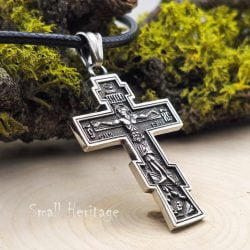
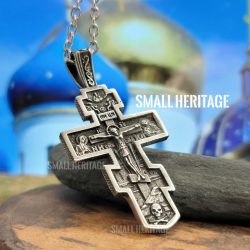
This cross features three horizontal bars, with the bottom bar slanted. It is widely used in the Russian Orthodox Church and symbolizes the theological beliefs specific to this branch of Orthodoxy. In jewelry, it is often seen as a Russian Orthodox Cross pendant or an ornate necklace, reflecting its distinctive form and deep spiritual meaning.
The Greek Orthodox Cross typically has a simpler design, with equal-length arms representing the four cardinal directions. It emphasizes the universality of Christ’s sacrifice and resurrection. As jewelry, it is frequently crafted as a Greek Orthodox Cross pendant, valued for its balanced proportions and understated elegance.
The Serbian Orthodox Cross often includes decorative elements such as flames or floral motifs, symbolizing the Holy Spirit and the beauty of creation. In jewelry, these details are beautifully expressed in gold Orthodox Cross pendants or silver designs, making them popular keepsakes for both faith and heritage.
Orthodox Cross pendants and necklaces are crafted from various materials, each adding to the piece’s beauty and significance. Common choices include:
The craftsmanship involved in creating these Orthodox Cross pendants and necklaces is meticulous, often involving detailed engraving, filigree work, and the setting of precious stones.
Orthodox Cross pendants and necklaces often feature inscriptions that add an additional layer of meaning and spiritual significance. These inscriptions can include prayers, biblical verses, or traditional phrases that hold deep religious meaning.
A common inscription found on Orthodox crosses is:
Да восстанет Бог, и расточатся враги Его, и да бегут от лица Его ненавидящие Его.
Translation: Let God arise, Let His enemies be scattered; Let those also who hate Him flee before Him.
Another frequent variation appears in Church Slavonic and Russian transliteration:
Da Voskresenet’ Bog’ i Razuidyutsya Vrazi Ego, I da Byezhat’ Ot’ Litsa Ego Vsi Nenavidashchey ego…
ДА ВОСКРЕСЕНЕТЪ БОГЪ И РАЗЫДУТСЯ ВРАЗИ ЕГО И ДА БЕЖАТЪ ОТЪ ЛИЦА ЕГО ВСИ НЕНАВИДЯЩЕЙ ЕГО…
Translation: Let God arise, and let His enemies be scattered; let them also that hate Him flee before Him.
On some crosses the inscription continues: “As smoke is driven away, so drive them away; as wax melts before the fire, so let the wicked perish at the presence of God.”
The full text originates from Psalm 67:1–2 in the Septuagint/Orthodox tradition (Psalm 68:1–2 in the King James Version).
Such inscriptions not only enhance the aesthetic appeal of the cross but also serve as a profound reminder of divine protection, offering spiritual comfort and inspiration to the wearer.
Choosing the right piece involves design, material, and personal significance:
Design: Select a style (Russian, Greek, Eastern) that resonates with your faith and aesthetics.
Material:Gold for warmth and tradition; silver for timeless elegance; stainless steel for durability.
Pendant‑only or Set: Many prefer a pendant to pair with their own chain; others choose a complete necklace for convenience.
Chain Compatibility: Check bail size and chain thickness/length for comfort.
Size & Daily Wear: Choose proportions that suit your wardrobe and purpose (devotional wear vs. special occasions).
Ready to find yours? Browse our Orthodox Cross necklaces and pendants.
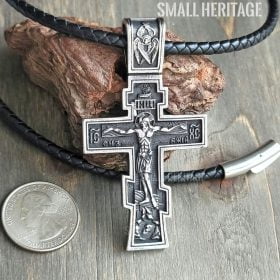
Proper care is essential to maintain the beauty and integrity of your Orthodox Cross pendant or necklace.
Orthodox cross necklaces have transcended their religious origins to become popular fashion accessories. Celebrities and fashion enthusiasts often wear these necklaces, appreciating their intricate designs and cultural significance. Despite this trend, the necklaces’ spiritual meaning remains intact, serving as a bridge between tradition and contemporary fashion.
Orthodox Christianity traces its origins to the earliest days of the Christian Church, developing distinct traditions and theological practices over centuries. The Great Schism of 1054 marked the separation between the Eastern Orthodox Church and the Roman Catholic Church, leading to differences in doctrine, liturgy, and ecclesiastical structure.
While both branches share core Christian beliefs, they differ in several areas:
The Armenian Apostolic Church is part of the Oriental Orthodox communion, which separated from the Eastern Orthodox Church over theological disputes following the Council of Chalcedon in 451 AD. Key differences include:
Orthodox crosses differ from other Christian crosses in design and symbolism. While the Latin cross is the most recognized symbol of Christianity, the Orthodox cross includes additional bars and elements that carry specific theological meanings. Understanding these differences enriches one’s appreciation of the diverse expressions of Christian faith.
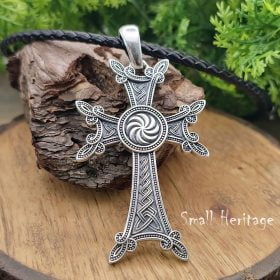
The Armenian cross, or the Armenian Apostolic cross, is a distinctive form with a unique design characterized by its flared ends and intricate detailing. It is often seen in the Armenian Apostolic Church and symbolizes the deep-rooted Christian heritage of the Armenian people.
References: Armenian Cross and Khachkars, Armenian-History.com
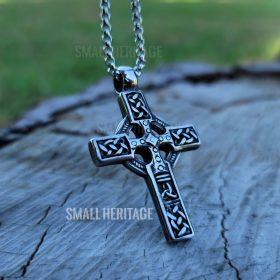
The Celtic cross, known for its ring surrounding the intersection of the arms, combines the traditional Christian cross with ancient Celtic symbols. It represents both faith and cultural heritage and is widely used in Ireland and other Celtic regions.
The Latin cross, also known as the Christian cross, is the most recognized symbol of Christianity. It consists of a simple vertical bar intersected by a horizontal bar near the top. This cross symbolizes the crucifixion of Jesus Christ and is widely used in Western Christianity.
The Coptic cross is used by the Coptic Orthodox Church of Alexandria. It has a distinctive design with equal-length arms and often includes intricate patterns or circles at the ends of the arms, representing eternity and the divine nature of Christ.
The Jerusalem cross, also known as the Crusader’s cross, features a large cross surrounded by four smaller crosses. It symbolizes the five wounds of Christ and was used during the Crusades to represent the mission to spread Christianity.
The Maltese cross, associated with the Knights of Malta, has eight points representing the eight obligations or aspirations of the knights. It is a symbol of Christian warrior values and is used by various Christian orders and military organizations.
By understanding these various cross designs and their unique meanings, one can appreciate the rich diversity within Christian symbolism and how each tradition has expressed its faith through distinct and meaningful symbols.
When purchasing an Orthodox cross necklace, it’s essential to choose a reputable seller to ensure authenticity and quality. Small Heritage offers a wide selection of genuine Orthodox Cross pendants and necklaces, crafted with precision and care. Visit our Slavic Jewelry or Russian Orthodox Cross Necklace Collection to explore our range of beautiful and meaningful pieces.

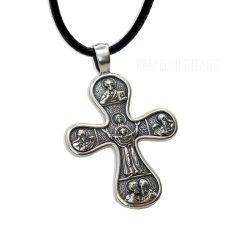

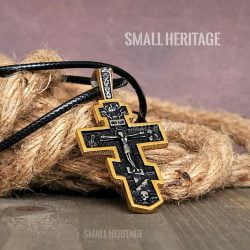
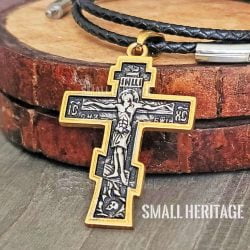


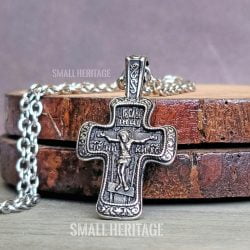

Orthodox Cross pendants and necklaces are timeless symbols of faith, heritage, and craftsmanship. Whether worn daily or on holy days, each piece carries profound meaning and an unbroken link to tradition. By understanding the history, symbolism, and variations of the Orthodox Cross, you can choose a design that resonates with your journey — and find one that becomes part of your own story.